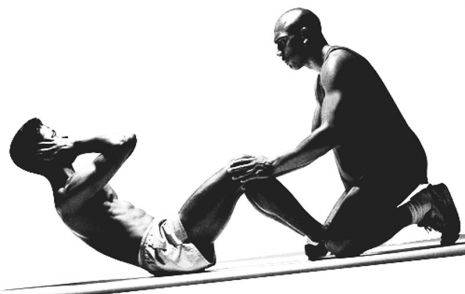(单词翻译:单击)
How many times have you gone to the gym and asked yourself, "Which should I do first: cardio or strength training?" The answer depends on whom you ask.
有多少次你去健身房,然后问自己,“到底是先进行有氧运动,还是先进行力量训练呢?”问题的答案取决于你问谁。
A recent study commissioned by the American Council on Exercise suggests that the order in which you do various exercises matters to your body and mind. The study also found that performing cardio exercises ( running, cycling, swimming or jumping rope, for instance) before strength training (think weightlifting or resistance exercise) appears to be most beneficial.
最近,由美国运动协会负责的一项研究表明,你做各种各样运动的顺序对你的身体和心理有很重要的影响。研究还发现,先进行有氧运动(比如跑步,骑自行车,游泳,跳绳等)再做力量训练(如举重和抗阻训练),似乎是最有益的。
While the findings from this type of research are valuable, they're not the be-all and end-all. Sometimes it makes more sense to start with cardio and other times you're better off hitting the weights first, when you're well-rested and fresh. Here are several scenarios that can help you determine how to sequence your exercise:
虽然这类研究的结果很有价值,但它们并不是运动的全部和终结。有时候先做有氧运动更有意义,而有时如果你休息充分又神清气爽,先做举重训练倒不失为一个明智的选择。下面是一些情景,来帮助你决定如何安排运动的次序。

Strength train first if: You engage in cardio exercise four to five days a week and also lift weights on two of those days. Beginning with strength training (after a warm up) and finishing with a moderate cardio workout will help you make the most of your limited strength training sessions. The two workout days when you skip the weights can be saved for high-intensity cardio workouts.
力量训练优先:如果你一周内进行有氧运动四五天并且其中两天都有举重,那这个时候,热身之后开始力量训练,并以适度的有氧锻炼来结尾,将会帮助你充分利用有限的力量训练。其中遗漏举重的两天可以用来存贮力量,以备高强度的有氧锻炼。
Do cardio first if: You have a relatively easy strength training session planned. No matter how hard you push during your cardio, you probably won't significantly compromise your lower-intensity lifting.
有氧运动优先:你计划中的力量训练相对比较简单。无论你多么努力地进行有氧运动,你可能不要明显地在低强度的举重上妥协。
Do cardio, then strength train, then cardio again if: You like to switch up your routine and cardio is your primary focus. Start your workout with 20 minutes of cardio, then strength train, then finish with 20 more minutes of cardio.
先有氧运动,然后力量训练,再回到有氧运动:如果你想改变一下惯例并且有氧运动是你优先考虑的。那请以20分钟的有氧运动来开始,然后进行力量训练,然后再以20分钟的有氧运动结束。
Strength train, then do cardio, then strength train again if: Improving total body muscle fitness is your major goal. Start with lower body strength exercises, then do 30 minutes of cardio and finish off with your upper body strength routine.
力量训练,然后是有氧运动,接着回到力量训练:如果改善肌适能是你的主要目标。那么以下肢的力量训练开始,然后进行30分钟的有氧运动,并以上肢的力量训练结束。
Choosing the Right Sequence for You
选择合适的运动顺序
You may go through phases in your training when developing your cardio fitness is more important to you than developing strength, or vice versa. During those phases, I recommend starting each workout with the activity that is your priority in order to achieve optimal results.
在你的锻炼中,你会经历有氧健身比力量训练更重要的阶段,反之亦然。期间,我建议从你擅长的活动开始以此来达到最理想的效果。
By mixing up the workout approach -- cardio first on some days, strength training first on other days, cardio and strength on separate days, and even two separate workouts in one day -- you can reap many health and fitness benefits.
通过把这些锻炼方式结合起来——时而有氧优先,时而力量训练优先,或者有氧和力量分开在不同的日子,甚至两种不同的锻炼在同一天——你可以收获健康和健身的益处。
The added variety can also provide a much needed mental and physical break. Changing the timing and order of the exercises in a workout program is yet another way to keep workouts fresh, eliminate boredom, avoid training plateaus and achieve maximum results. Ultimately, what matters most is that you consistently perform both cardio and strength training -- in any order, on any days, at any time -- and progressively challenge yourself to improve your overall fitness.
额外的运动种类可以让你的心理和身体得到休息。在锻炼中改变时间和顺序还是保持锻炼的新鲜感的另一个途径,还可以消除乏味,摆脱运动停滞期,来达到最大的效果。最后,最重要的是不论你用什么顺序,在哪天,在什么时间,你要始终如一的进行有氧和力量训练,并逐步地挑战自己来增强整体素质。
Cedric X. Bryant, Ph.D., FACSM, is the chief science officer at the American Council on Exercise,where he is a national and international lecturer, writer and subject-matter expert. Dr. Bryant is also a member of the Institute of Medicine's Round table on Obesity Solutions and serves as vice chair of the Osteoarthritis Action Alliance's Physical Activity Working Group. He has participated in the Aspen Institute's Project Play Summit and served on the National Physical Activity Plan's Health Care Sector Expert Panel. Dr. Bryant helps to advance ACE's mission and impact by staying at the forefront of applied physiological research, exercise training methods, and health and fitness trends.
美国运动医学会会员塞德里克·布莱恩特博士,是美国运动协会的首席科学执行官,是国内和国际发言人,作者和主题专家。布莱恩特博士还是研究肥胖问题的医学圆桌会议学会的成员,担任骨关节炎体育活动小组联盟的副主席。他还参与了阿斯彭研究所的项目峰会并服务于国家体育活动计划的卫生保健行业专家小组。他帮助美国电影电视剪接师协会完成任务,在应用生理研究的前沿,运动训练方法和健康健身趋势方面造成了影响。


